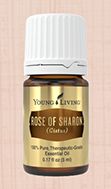TWELVE OILS OF ANCIENT SCRIPTURE: ROSE OF SHARON
EDITOR’S NOTE: Since Gary Young’s passing, we have been taking stock of the tremendous contributions he made to the world by revisiting his presentations, such as this fascinating multipart blogpost series called The Twelve Oils of Ancient Scripture. In it, Gary examined the historical significance and traditional uses of frankincense, sandalwood, myrrh, onycha, spikenard, rose of Sharon, myrtle, hyssop, galbanum, cypress, cedarwood, and cassia. Less known about are onycha, spikenard, and rose of Sharon, but in this post, Gary Young imparted his knowledge of the rose of Sharon, one of these precious oils of ancient scripture.
 The rose of Sharon is believed to be ladinum, Cistus ladanifer. This herb was imported into ancient Egypt from the island of Crete in the Mediterranean Sea. The resin, which collected on the leaves, was treasured for its distinctive aromatic and therapeutic properties. The scriptural reference of rose of Sharon is in Solomon 2:1 where it says “I am the rose of Sharon, and the lily of the valleys.” The beautiful oil of cistus has a soft, honey-like scent. And cistus may be the small shrub tree called the rose of Sharon. Anciently it was referred to as the lily of the valley.
The rose of Sharon is believed to be ladinum, Cistus ladanifer. This herb was imported into ancient Egypt from the island of Crete in the Mediterranean Sea. The resin, which collected on the leaves, was treasured for its distinctive aromatic and therapeutic properties. The scriptural reference of rose of Sharon is in Solomon 2:1 where it says “I am the rose of Sharon, and the lily of the valleys.” The beautiful oil of cistus has a soft, honey-like scent. And cistus may be the small shrub tree called the rose of Sharon. Anciently it was referred to as the lily of the valley.
There’s still more to come! Next, I’ll address some of the historical uses of myrtle and hyssop. I hope you’ll join me.
Essentially Yours,
Gary Young
(Originally published January 19, 2010)

